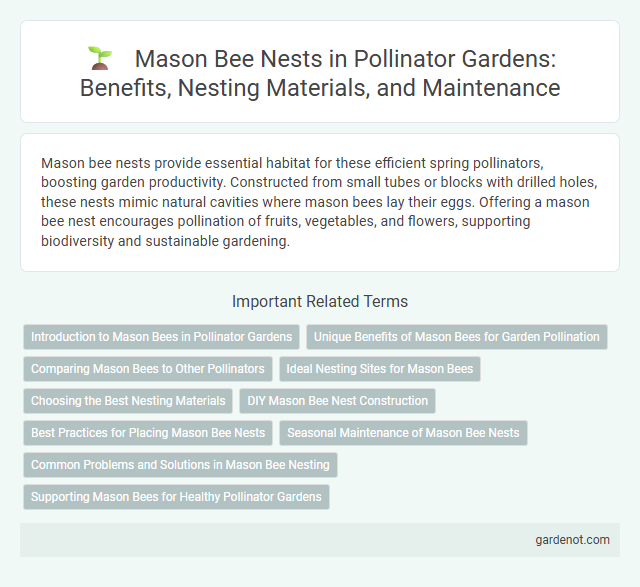Mason bee nests provide essential habitat for these efficient spring pollinators, boosting garden productivity. Constructed from small tubes or blocks with drilled holes, these nests mimic natural cavities where mason bees lay their eggs. Offering a mason bee nest encourages pollination of fruits, vegetables, and flowers, supporting biodiversity and sustainable gardening.
Introduction to Mason Bees in Pollinator Gardens
Mason bees play a crucial role in pollinator gardens by enhancing the pollination of a wide variety of flowers, fruits, and vegetables. These solitary bees nest in small cavities, such as hollow stems or specially designed bee houses, where they deposit pollen and lay eggs. Their efficient, gentle nature makes them ideal for improving garden biodiversity and boosting crop yields without the aggression associated with honeybees.
Unique Benefits of Mason Bees for Garden Pollination
Mason bees provide exceptional garden pollination through their efficient, solitary nesting behavior, which results in a higher pollination rate per individual compared to honeybees. Their ability to pollinate early spring blossoms enhances fruit set and boosts overall garden productivity, especially for crops like apples, cherries, and blueberries. By nesting in pre-existing cavities and using mud to create individual brood cells, mason bees minimize space and resource competition, supporting a diverse and resilient pollinator ecosystem.
Comparing Mason Bees to Other Pollinators
Mason bees are highly efficient pollinators, outperforming honeybees by pollinating up to 3000 flowers daily due to their solitary and non-aggressive nature. Unlike bumblebees, mason bees are less sensitive to temperature fluctuations and begin foraging earlier in the spring, enhancing early bloom pollination. Their unique nesting habits in small cavities make them easier to support in home gardens, offering a sustainable alternative to traditional hive-based pollinators.
Ideal Nesting Sites for Mason Bees
Ideal nesting sites for mason bees include hollow stems, wood cavities, and pre-existing holes in natural or artificial materials such as bee blocks or bundles of hollow reeds. These sites should be sheltered from rain and direct sunlight, ideally facing east or southeast to maximize morning warmth. Providing clean, dry, and predator-protected environments significantly enhances nesting success and supports robust pollinator populations.
Choosing the Best Nesting Materials
Selecting the best nesting materials for mason bee nests significantly boosts pollination success and bee health. Natural materials such as untreated wood blocks with pre-drilled holes, hollow bamboo tubes, or paper straws mimic the bees' native habitats and provide ideal protection for larvae. Avoiding synthetic or chemically treated materials prevents contamination and supports sustainable mason bee populations in pollinator gardens.
DIY Mason Bee Nest Construction
Building a DIY Mason bee nest supports pollinator populations by providing essential habitats for native bees, which are vital for crop and wild plant pollination. Use untreated wood blocks or hollow plant stems, drilling holes 5/16 inch in diameter and 4-6 inches deep, ensuring smooth edges to prevent bee injury. Place the nest in a sunny, sheltered location facing southeast to maximize warmth and encourage bee activity throughout the spring season.
Best Practices for Placing Mason Bee Nests
Mason bee nests should be placed in a sunny location, ideally facing southeast to maximize morning warmth and activity. Position nests at least 3 feet above the ground to protect against predators and moisture damage. Ensure the site is close to mud sources and flowering plants, as these are essential for mason bee nesting and feeding.
Seasonal Maintenance of Mason Bee Nests
Mason bee nests require seasonal maintenance to ensure optimal bee population and health, including cleaning out old nesting materials in early spring before bee emergence. After the bees complete their life cycle, removing debris and replacing damaged tubes helps prevent parasites and mold that can threaten larvae. Regular inspection and replacement of nesting components in late fall prepares the habitat for the next season's mason bee activity and maximizes pollination efficiency.
Common Problems and Solutions in Mason Bee Nesting
Mason bee nests often face challenges such as mud blockages, parasite infestations, and improper moisture levels causing larval mortality. Regular cleaning of nesting tunnels and providing well-drained nesting materials help prevent blockages and fungal growth. Installing predator guards and monitoring for parasitic wasps can significantly reduce brood loss, enhancing successful mason bee reproduction.
Supporting Mason Bees for Healthy Pollinator Gardens
Mason bee nests provide essential shelter that supports the lifecycle of solitary mason bees, crucial pollinators for diverse garden plants. Installing tubular, weather-resistant nesting blocks near flowering plants enhances local mason bee populations, increasing pollination efficiency and crop yields. Ensuring pesticide-free environments around nests further promotes healthy, active mason bee colonies vital for sustainable pollinator gardens.
Mason bee nest Infographic

 gardenot.com
gardenot.com